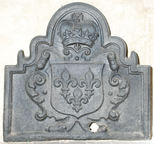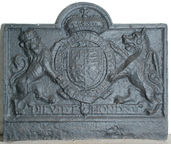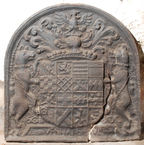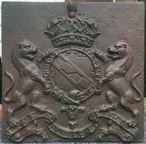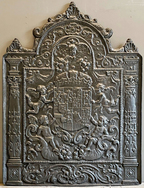-
483
Description: Plain plate with scrolled side edges; canted arched rectangular astragal and fillet top moulding; central shield, crest and motto of the hardy family.
Inscription: ARMEE DE FOI HARDI
Arms: Hardy
- Decoration tags:
- rectangular with canted top corners and round arch (shape)
- none (edging)
- whole carved pattern
- armorial
- text
Manufactured: in the late-19th century at Low Moor Furnace in the Yorkshire area of England.
Current location: in private hands, Maresfield, East Sussex, England.
- Attached to series:
- Personal armorial firebacks
-
817
Description: Arched rectangular shape; fillet edging; shield, helm, crest and mantling of the Worshipful Company of Blacksmiths (see Fig. 3); date in top corners; initials at bottom, below mantling; two planklines.
Notes: One of the hooked ‘1’ series; a copy from an evenly impressed original.
Copies of this fireback are known.
Inscription: 16 50 / I M
Arms: Worshipful Company of Blacksmiths
- Decoration tags:
- rectangular with round arch (shape)
- fillet (edging)
- whole carved pattern
- planklines
- armorial
- text
Manufactured: in 1650 possibly at Brede Furnace in the Weald area of England.
Current location: in private hands, Mayfield, East Sussex, England.
- Attached to series:
- Hooked '1' series
- Livery company firebacks
- Brede group
- IM series
-
823
Description: Arched shape with ovolo egg-and-dart edging; crown surmounting a shield, a quartered shield with an escutcheon impaling a crowned lion rampant with an escutcheon; text along the bottom.
Notes: The arms have not been identified; LOVEN is the town of Leuven, capital of the province of Brabant, which, in 1662, was in the Spanish Netherlands.
Inscription: LOVEN 1662
- Decoration tags:
- rounded arched (shape)
- ovolo, egg and dart (edging)
- carved pattern panels
- armorial
- text
- plants
Manufactured: in 1662 possibly in the Ardennes area of Belgium.
Current location: in private hands, Mayfield, East Sussex, England.
- Attached to series:
- Foreign armorial firebacks
-
488
Description: Rectangular with complex quasi-arched rectangular top; fillet edging; shield with Royal arms of France in a cartouche; above, an English crown.
Notes: The combination of the English crown and French arms is common and may relate to the marriage of Charles I and Princess Henrietta Maria of France in 1625. A different version is no. 659. Said to have been cast by Thomas Prickett (1727-95) at Gloucester Furnace, Lamberhurst. Formerly part of the J. H. Every collection.
Copies of this fireback are known.
Arms: France modern
- Decoration tags:
- rectangular with round arch (shape)
- fillet (edging)
- whole carved pattern
- armorial
- royal
Manufactured: in the early- to mid-17th century probably at Gloucester Furnace, Lamberhurst in the Weald area of England.
Current location: Michelham Priory, Arlington, East Sussex, England.
Museum number: 1944.24.068 (part of the Sussex Archaeological Society museum group)
Citation: Dawson, C., 1903, 'Sussex Iron Work and Pottery', Sussex Archaeological Collections, 46, pp. 1-54.
- Attached to series:
- Ornate border series
- Miscellaneous royal firebacks
- Anglo-French armorial firebacks
-
491
Description: Armorial; one plank line; shield, supporters, helm, crest and garter of the Sackville family: quarterly or and gules, a bend vair.
Notes: The arms of Thomas Sackville (1527-1608), created 1st Baron Buckhurst in 1567 and invested Knight of the Garter in 1589. He was MP for East Grinstead. He was created 1st Earl of Dorset in 1604; the back therefore dates between 1589 and 1604.
Copies of this fireback are known.
Inscription: HONI ... MAL Y PEN ...
Arms: Sackville, Baron Buckhurst
- Decoration tags:
- complex quasi-arched (shape)
- ovolo (edging)
- whole carved pattern
- planklines
- armorial
- text
Manufactured: in the late-16th to early-17th century in the Weald area of England.
Current location: Michelham Priory, Arlington, East Sussex, England.
(part of the Sussex Archaeological Society museum group)
Citation: Butterfield, W. R., 1916, 'Old Wealden Firebacks', The Connoisseur, 46, pp. 197-209.
- Attached to series:
- Ornate border series
- Personal armorial firebacks
- Sackville firebacks
-
496
Description: Arched rectangular shape; ovolo moulded edging; plain panel at bottom; Tudor royal shield, garter, crown, motto and supporters (crowned lion and dragon), temp. Elizabeth I; the top of the lion's crown and the dragon's ear overlap the edging.
Notes: Another version has a rose and portcullis either side of the crown, and the top of the lion's crown and the dragon's ear do not overlap the edging.
Inscription: [Garter] HONI SOIT QVI MAL E PENSE / [motto] DIEV ET MON DROIT.
Arms: Tudor royal
- Decoration tags:
- rectangular with round arch (shape)
- ovolo (edging)
- whole carved pattern
- planklines
- armorial
- royal
- text
Manufactured: in the mid- to late-16th century in the Weald area of England.
Current location: Michelham Priory, Arlington, East Sussex, England.
Museum number: LH000.999 (part of the Sussex Archaeological Society museum group)
- Attached to series:
- Tudor royal armorial firebacks
- Tudor royal armorial (plain) series
-
498
Description: Arched plate; ovolo moulding edging; shield, supporters, coronet, helm, crest and motto of Viscount Montague; quarterly Browne, Albini, Fitzalan, Fitzalan of Clare, Warren, Maltravers, Nevill, Montagu, Monthermer, Inglethorpe, Burghe, Delapole, Bradeston, Tiptoft, Charleton and Kent (Plantagenet); supporters: two bears collared and chained; the crest: an eagle, the wings elevated and displayed.
Notes: The arms of either the 2nd (Anthony-Maria Browne, succ. 1592-1629) or 3rd viscount (Francis Browne succ. 1629-1682) - the 1st viscount was a Knight of the Garter and no garter is shown; the style of the modelling bears similarities to that on the 1618 series of firebacks and may be the work of the same pattern-maker.
Inscription: 16 / VERITATE DUCE [Be led by Truth]
Arms: Viscount Montague
- Decoration tags:
- rounded arched (shape)
- ovolo (edging)
- whole carved pattern
- armorial
- text
Manufactured: in the late-16th to early-17th century in England.
Current location: Cowdray House ruins, Midhurst, West Sussex, England.
Citation: Dawson, C., 1903, 'Sussex Iron Work and Pottery', Sussex Archaeological Collections, 46, pp. 1-54.
Citation: Gardner, J. S., 1898, 'Iron Casting in the Weald', Archaeologia, 56, 1, pp. 133-164.
- Attached to series:
- Cowdray firebacks
- Personal armorial firebacks
-
499
Description: Arched rectangle; dentil ovolo-moulded edging; shield, supporters, coronet, helm, crest, mantling and motto of Viscount Montague; quarterly Browne, Albini, Fitzalan, Fitzalan of Clare, Warren, Maltravers, Nevill, Montagu, Monthermer, Inglethorpe, Burghe, Delapole, Bradeston, Tiptoft, Charleton and Kent (Plantagenet); supporters: two bears collared and chained; the crest: an eagle, the wings elevated and displayed.
Notes: The arms of either the 2nd (Anthony-Maria Browne, succ. 1592-1629) or 3rd viscount (Francis Browne succ. 1629-1682) - the 1st viscount was a Knight of the Garter and no garter is shown.
Copies of this fireback are known.
Inscription: VERITATE DUCE [Be led by Truth]
Arms: Viscount Montague
- Decoration tags:
- rectangular with round arch (shape)
- dentil ovolo (edging)
- whole carved pattern
- armorial
- text
Manufactured: in the late-16th to early-17th century in England.
Current location: Cowdray House ruins, Midhurst, West Sussex, England.
- Attached to series:
- Cowdray firebacks
- Personal armorial firebacks
-
390
Description: Rectangular; plain plate with shield, supporters, ducal coronet, motto and garter of the Duke of Dorset: Quarterly, Or and gules, a bend vair.
Notes: Almost certainly the arms of Lionel Sackville KG (1688-1765), created first duke of Dorset in 1720. This particular design of fireback has been produced in a variety of sizes depending on the space around the achievement of arms
Copies of this fireback are known.
Inscription: HONI SOIT QUI MAL Y PENSE / AUT NUNQUAM TENTES, AUT PERFICE [Either do not attempt, or complete]
Arms: Lionel Sackville, 1st Duke of Dorset
- Decoration tags:
- rectangular (shape)
- none (edging)
- whole carved pattern
- armorial
- text
Manufactured: in the early-18th century in the Weald area of England.
Current location: in private hands Milford, Surrey, England.
Citation: Lloyd, N., 1925, 'Domestic Ironwork I', Architectural Review, 58, pp. 58-67.
- Attached to series:
- Dorset arms series
- Personal armorial firebacks
- Sackville firebacks
-
1203
Description: Arched rectangular central panel with bead on fillet edging; central shield of the Dutch house of Orange impaling English royal Stuart, surmounted by a crown and supported by two putti; above, a maske with two descending grape bunches; below, two more putti seated on scrolls and cornucopiae; a drapery swag and bow in each top corner; arched rectangular border with cavetto-moulded edging and canted top corners; on each side, a Corinthian column and entablature on a pedestal, the columns with floriate decoration; below, a symmetrical swirled design; above the arch, from a scallop shell on each shoulder, two serpents rising towards a third scallop on top.
Notes: The arms are of William IV Prince of Orange (1650-1702) impaling those of his wife, Mary, Queen of Great Britain. Note, these are not the royal arms of William III and Mary II as joint sovereigns, but as Prince and Princess of Orange. William and Mary married in 1677 and Mary died in 1694, so the fireback dates from between 1689, when Mary became Queen, and 1694. A fireback of the same design with the arms of Louis XIV of France is illustrated by Elling and Winkler-Borck, p.213; it has the initials AD in the cartouche above the arch, not visible on this casting.
Arms: William of Orange
Manufactured: in the late-17th century possibly in the Siegerland area of Germany.
Current location: Lassco, Three Pigeons, Milton Common, , Great Milton, Oxfordshire, England.
Citation: Elling, W. & Winkler-Borck, S., 1992, Ofen- und Kaminplatten (Vreden, Hamaland-Museum).



